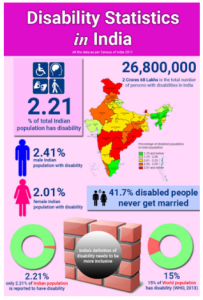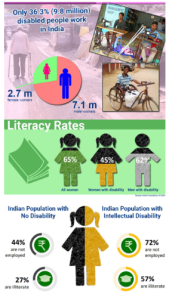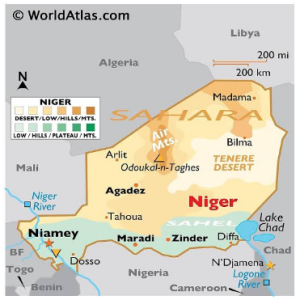Context: According to the Parliamentary Standing Committee on Social Justice and Empowerment, the Union government has failed to accurately estimate the current population of Persons with Disabilities (PwDs) in the country.
About PwDs (Divyangjan):

Key Challenges Faced by PwD in India:
 Poor implementation of accessibility guidelines: Although there are guidelines for making buildings and spaces accessible, they are often not implemented properly.
Poor implementation of accessibility guidelines: Although there are guidelines for making buildings and spaces accessible, they are often not implemented properly.Initiatives Taken by Government to Support PwDs:
Salient Feature of Rights of Persons with Disabilities Act, 2016:
|
Way Forward:
The Biwako Millennium Framework (BMF)
Incheon Strategy
|
News Source: The Hindu
Context: Recently, the Multi-State Cooperative Societies (Amendment) Bill, 2022, was passed by the Lok Sabha to amend the Multi-State Cooperative Societies (MSCS) Act, 2002
| Probable Question:
Q. Discuss the challenges faced by the cooperative sector. How does the Multi-State Cooperative Societies (Amendment) Bill, 2022 seek to address them? |
About Multi-State Cooperatives:
Need of the Multi-State Cooperative Societies (Amendment) Bill, 2022 Bill:
Key Provisions of the Multi-State Cooperative Societies (Amendment) Bill, 2022 Bill:
| Provision | Multi-State Cooperative Societies Act of 2002 | Multi-State Cooperative Societies (Amendment) Bill, 2022 |
| Election of Board Members |
|
|
| Amalgamation of co-operative Societies |
|
|
| Fund for sick co-operative societies: | — |
|
| Restriction on redemption of Government Shareholding |
|
|
| Redressal of Complaints | – |
|
Concern related to Bill:
Issues with the Cooperative Sector:
Constitutional Provisions:
|
Way Forward:
| Additional Information:
Magnitude of Cooperative Sector in India:
|
News Source: The Hindu
Context:
About the RECEIC:
Significance:
News Source: PIB
Context:
About the bill:
Measures Proposed:
Benefits of the Amendment Bill:
News Source: PIB
Context:
The Union government has approved a scheme called the Guarantee Scheme for Corporate Debt (GSCD), which aims to provide complete guarantee cover for debt raised by the Corporate Debt Market Development Fund (CDMDF).
More on News:
About CDMDF:
Framework Release by SEBI: The Securities and Exchange Board of India (SEBI) has released a framework for the CDMDF, outlining the guidelines and regulations for its operation.
| Key Terms:
Alternate Investment Fund:
|
News Source: The Indian Express
Context:
SEBI is reviewing delisting regulations for listed companies to prevent share manipulation in companies opting for delisting.
Delisting of Securities:
Reverse Book-Building Process:
SEBI’s Review:
Benefit of Fixed Price Method:
News Source: The Indian Express
Context:
The parliamentary committee on Finance urges the government to finalize the digital competition bill to address anti-competitive practices in digital markets.
More on News:
Recommendations of Standing Committee on Finance:
About Big Tech Companies:
Anti-competitive practices by Big Tech:
News Source: The Livemint
Context:
About Niger:

News Source: Indian Express
Context:
The latest data available with the Ministry of Consumer Affairs, Food and Public Distribution shows that the state governments can identify 1.24 crore more beneficiaries under the National Food Security Act, 2013.
Key Points about NFSA:
News Source: The Indian Express
SC Verdict on Newsclick Shows Adherence to Due Pro...
Stay Invested: On Chabahar and India-Iran Relation...
Credit Rating Agencies, Impact on India’s De...
Catapulting Indian Biopharma Industry
Globalisation Under Threat, US Import Tariffs Have...
Global Report on Hypertension, Global Insights and...
<div class="new-fform">
</div>
